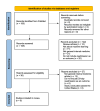The Role of Machine Learning in Predicting Hospital Readmissions Among General Internal Medicine Patients: A Systematic Review
- PMID: 40557003
- PMCID: PMC12187041
- DOI: 10.7759/cureus.84761
The Role of Machine Learning in Predicting Hospital Readmissions Among General Internal Medicine Patients: A Systematic Review
Abstract
Hospital readmissions contribute significantly to healthcare costs. While traditional regression models for predicting 30-day readmission risk offer modest accuracy, machine learning (ML) presents an opportunity to capture complex relationships in healthcare data, potentially enhancing predictions. This review assesses the role of ML in predicting 30-day readmissions for general internal medicine admissions in the U.S. Following the Preferred Reporting Items for Systematic reviews and Meta-Analyses (PRISMA) guidelines, a literature search of PubMed (2014-2023) was conducted using the keywords "artificial intelligence," "machine learning," and "readmission." The review focused on ML models predicting readmissions in general internal medicine patients in the U.S. Nine studies were reviewed, covering conditions like acute myocardial infarction (AMI), heart failure (HF), pneumonia (PNA), chronic obstructive pulmonary disease (COPD), and other general internal medicine cases. ML models such as artificial neural networks (ANN), random forests (RF), gradient boosting, logistic regression, and natural language processing (NLP) were used. ANN and RF models outperformed traditional regression methods, while NLP-based approaches showed limited success. Subgroup modeling provided marginal improvements in predictive accuracy. In conclusion, ML offers significant potential for improving 30-day readmission predictions by overcoming the limitations of traditional models. ANN and RF are particularly effective in predicting readmissions in general internal medicine. To advance predictive capabilities, future research should refine NLP, subgroup modeling, and focus on model generalizability, integration of diverse data sources, and the development of explainable AI for clinical adoption. Addressing these challenges could transform healthcare delivery, improve patient outcomes, and reduce costs.
Keywords: artificial intelligence; general internal medicine; machine learning; readmission; us based.
Copyright © 2025, Sharda et al.
Conflict of interest statement
Conflicts of interest: In compliance with the ICMJE uniform disclosure form, all authors declare the following: Payment/services info: All authors have declared that no financial support was received from any organization for the submitted work. Financial relationships: All authors have declared that they have no financial relationships at present or within the previous three years with any organizations that might have an interest in the submitted work. Other relationships: All authors have declared that there are no other relationships or activities that could appear to have influenced the submitted work.
Figures


Similar articles
-
Machine Learning and Natural Language Processing in Mental Health: Systematic Review.J Med Internet Res. 2021 May 4;23(5):e15708. doi: 10.2196/15708. J Med Internet Res. 2021. PMID: 33944788 Free PMC article.
-
A Systematic Review and Bibliometric Analysis of Applications of Artificial Intelligence and Machine Learning in Vascular Surgery.Ann Vasc Surg. 2022 Sep;85:395-405. doi: 10.1016/j.avsg.2022.03.019. Epub 2022 Mar 24. Ann Vasc Surg. 2022. PMID: 35339595
-
The comparative and added prognostic value of biomarkers to the Revised Cardiac Risk Index for preoperative prediction of major adverse cardiac events and all-cause mortality in patients who undergo noncardiac surgery.Cochrane Database Syst Rev. 2021 Dec 21;12(12):CD013139. doi: 10.1002/14651858.CD013139.pub2. Cochrane Database Syst Rev. 2021. PMID: 34931303 Free PMC article.
-
Self-management interventions including action plans for exacerbations versus usual care in patients with chronic obstructive pulmonary disease.Cochrane Database Syst Rev. 2017 Aug 4;8(8):CD011682. doi: 10.1002/14651858.CD011682.pub2. Cochrane Database Syst Rev. 2017. PMID: 28777450 Free PMC article.
-
Home treatment for mental health problems: a systematic review.Health Technol Assess. 2001;5(15):1-139. doi: 10.3310/hta5150. Health Technol Assess. 2001. PMID: 11532236
References
-
- Rehospitalizations among patients in the Medicare fee-for-service program. Jencks SF, Williams MV, Coleman EA. N Engl J Med. 2009;360:1418–1428. - PubMed
-
- Patient Protection and Affordable Care Act. [ Jan; 2025 ]. 2025. https://www.healthcare.gov/glossary/patient-protection-and-affordable-ca... https://www.healthcare.gov/glossary/patient-protection-and-affordable-ca...
-
- Readmission penalties and health insurance expansions: a dispatch from Massachusetts. Chen C, Scheffler G, Chandra A. https://doi.org/10.1002/jhm.2213. J Hosp Med. 2014;9:681–687. - PubMed
-
- Differences in hospital readmission risk across all payer groups in South Carolina. Chakraborty H, Axon RN, Brittingham J, Lyons GR, Cole L, Turley CB. https://doi.org/10.1111/1475-6773.12579. Health Serv Res. 2017;52:1040–1060. - PMC - PubMed
Publication types
LinkOut - more resources
Full Text Sources
Research Materials
Miscellaneous
